|
Surface Pro 4 is undeniably Microsoft's best Surface tablet yet that can replace your laptop. It's faster, the screen is a third of an inch bigger and it runs at a higher resolution. Windows 10 brings further improved display scaling and (finally!) Adobe CC programs play nicely with these high resolution beauties. Pricing remains the same as with the Surface Pro 3 line, and that means you can grab the base model Core m3 for $899. The Core i5 starts at $999, while the more desirable (for laptop replacement use) 8 gigs of RAM and 256 gig SSD model will set you back $1299. The improved Surface Pro 4 Type Cover is $129, and it's compatible with the Surface Pro 3 too. For those with high performance needs, ample bank accounts and a little patience, the Core i7 with Intel Iris graphics will be out by late November. The top model sells for $2,600 (16 gigs RAM and 1 TB SSD), and if you want a high performance Surface product sooner, you might want to consider the new Surface Book with the same Core i7 and NVIDIA graphics for $2,100, though that seems to be selling out everywhere. Since this is Microsoft's own product, it's functionally a "Signature Edition", which means there's absolutely no bloatware. Nada. Zip. Nice. It ships with Windows 10 Pro rather than Home, which will excite IT types more than home users.
Standard features include Intel 6th generation Skylake CPUs with integrated graphics, dual band Marvell Avastar WiFi 802.1ac, Bluetooth 4.0, a front 5MP camera and a rear 8MP camera. I do wonder why Microsoft doesn't use Intel's WiFi/Bluetooth chipset, which I find offers stronger WiFi performance than Marvell's. The front camera works with Windows Hello, Microsoft's impressively reliable facial recognition for logging into Windows. As ever, the keyboard is sold separately and it's available in two versions: the $129 standard Type Cover and the $159 version that adds a fingerprint scanner. The tablet has stereo speakers located on the sides of the display, and they sound louder and fuller than Surface Pro 3's speakers.
Looks and Feels a Lot Like Surface Pro 3
Surface Pro 4 weighs 1.73 lbs. (1.69 lbs. for the Core M model) and is just 8.45mm (0.33 inches) thick. The industrial design is the same as last generation, and that's fine with us since it's iconic, looks chic and it works well. From the kickstand that resists bounce to the elegantly concealed speakers and ventilation, it's all good. Even better, Microsoft has revised the cooling to dissipate and spread heat better, so there's no single hotspot that gets burning hot and the fan comes on much less often and is significantly quieter when it does come on. For those who want no fan noise, the Core m3 model is fanless. We have both the Core m3 and the Core i5 models in house, so we'll provide info for both.
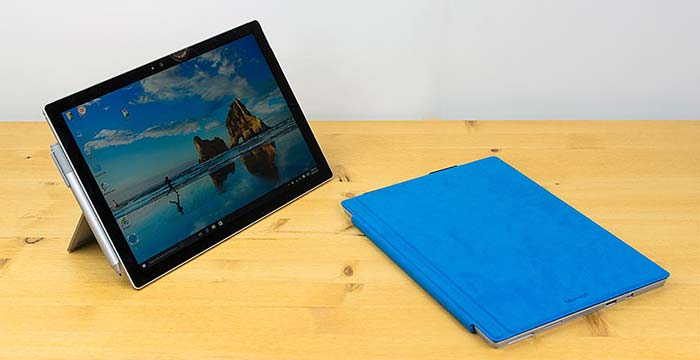
As ever, this isn't a computer that you'll casually open for upgrades. It's darned hard to take it apart and RAM is soldered, so you can't upgrade it. You could upgrade the PCIe SSD, but again, to access the internals you'd have to remove the display that's held in place with adhesives. I take apart nearly every laptop that comes in house for review, but I won't disassemble tablets like the Surface models.
Is the magnesium alloy clad Surface Pro 4 really quieter and cooler? Our Core i5 Pro 4 is a very different beast from my Surface Pro 3 Core i5. Pro 3's fan came on seemingly randomly and very audibly, even when I wasn't doing anything particularly demanding. Pro 4 with the Core i5 has a much quieter fan (it's a loud whisper compared to the SP3's hand vac), and the fan doesn't inexplicably ramp up when simply browsing the web or writing an email. When playing Bioshock Infinite or editing 1080p footage in Adobe Premiere Pro, the fan is on constantly, and that's fair since the tablet is working hard. That said, the fan isn't egregiously loud and your family members won't ask you to leave the room so they hear the TV. Good job, Microsoft.
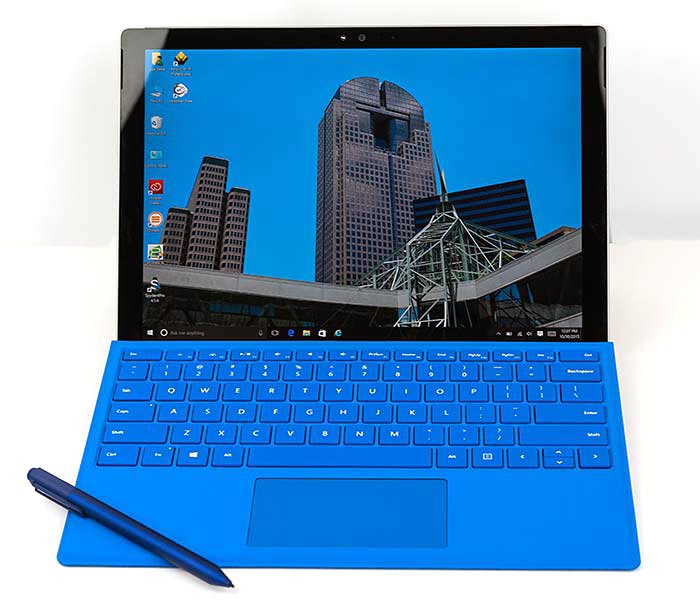
The Intel Core m3 model has no fan, so if you're a fan of silence, it's your tablet. The back gets quite warm when the Pro 4 is working hard, but we didn't see any problematic thermal throttling and it never became too hot to hold. That said it can get very warm on the back if you're gaming or exporting video; enough to moisten your palms.
A Few Bugs at Launch
Update Nov. 2, 2015: Microsoft released driver and firmware updates to fix the display bugs, and so far they seem to be working well. We'll leave this section a bit longer until we're sure the bugs are squashed.
Hopefully in a few weeks, these issues will be resolved, but until then we'll note bugs here. Some folks have reported that their Core i5 Surface Pro 4 has a rowdy fan, and I suspect that has something to do with Microsoft's promising but very buggy new default web browser, Edge (our two units didn't have this problem). For better or worse, Surface Pro models always ship with bugs at launch, and we suspect Microsoft will iron things out within a month or so. Speaking of bugs, we've seen a few display driver crashes; the new Intel HD 520 driver has been problematic on several different computers models we've tested, not just Surface. Again, Microsoft expects to have a driver update with a fix in November. Another display driver + MS Edge bug results in browser windows sometimes changing color temperature during scrolling (that one looks freaky enough to make you think the hardware is defective, but it's simply a software issue). Multiple 4K monitors attached to the optional $199 Surface Dock sometimes misbehave (graphics driver strikes again). Lastly, the speakers sometimes pop, generally when scrolling or closing a web page that has an embedded video.
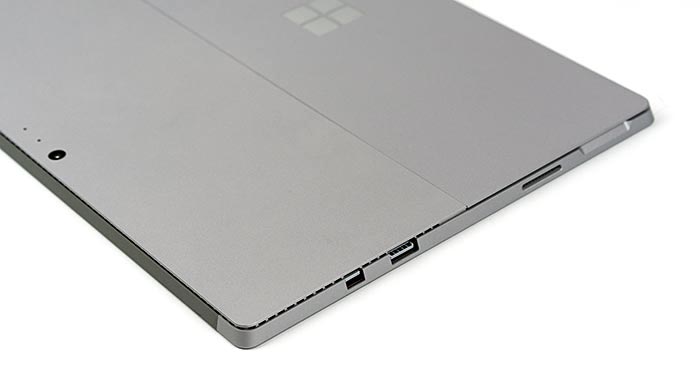
Ports and the New Surface Dock
Ports are typically lacking in tablets, and you get just 1 USB 3.0 port, 1 mini DisplayPort, a 3.5mm audio jack and the usual microSD card slot hidden under the kickstand. There are third party adapters, some of which we've reviewed, that snap onto the tablet's side and provide additional USB ports and a full size SD card slot. Microsoft sells an Ethernet adapter, HDMI adapter (you can find a mini DisplayPort to HDMI adapter cheaper than Microsoft's though) and a new dock that works with Surface Pro 3, Surface Pro 4 and Surface Book. It's a weighted black rectangle that plugs into the magnetic charging port and adds 4 USB 3.0 ports, two mini DisplayPorts, Ethernet and another 3.5mm audio port. It comes with a charger that's significantly larger than the one included with the Pro, that's fine since a dock is meant to stay on your desk rather than travel with you. We noted that the Surface Pro 4 and Surface Book were buggy with the dock when we plugged two 4K monitors into the dock. That's due to graphics driver issues, which should get ironed out. And yes, Surface Pro 4 can drive 4K monitors at 60Hz--that's a standard feature for Intel Skylake and its integrated graphics.
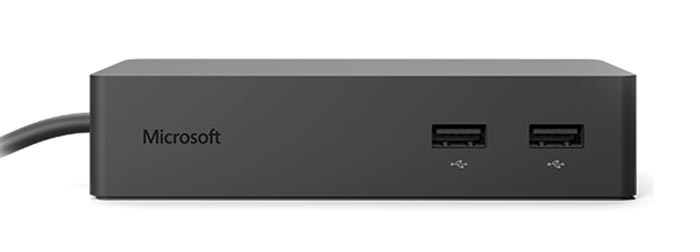
Pen and Display
Microsoft Surface Pro 4 has a 3:2 aspect ratio touch screen with an N-Trig digitizer that supports 1024 levels of pressure sensitivity vs. 256 levels in Surface Pro 3 (the change is in the display's digitizer, not the pen). The pen is included and it's updated too with a softer nib (pen tip) that's quieter and feels less slippery on the glass. Microsoft sells a 5 pack of alternative nibs for slight variations in feel, and the nib pack is included if you buy a spare $59 pen (available in a few colors). The new pen has a rubbery eraser that... erases... and a single hidden side button that by default acts as a right click. Writing and drawing feels more fluid, though still not quite as buttery as Wacom EMR digitizers and pens. N-Trig beats Wacom for better tracking near the edges of the display and it has less parallax (pen offset). I do digital drawing and painting as a hobby, and I might be inclined to agree with the folks at N-Trig who once told me that 256 vs. 1024 levels of pressure sensitivity matters less than good pen pressure tracking and registration (aka good pressure curves). I can't say I 'feel" the added pressure levels, but I do notice improvements in pressure curves that better mimic pen and brush on paper and canvas. This is certainly the most responsive and enjoyable N-Trig experience yet, and that's not faint praise. It's similar to the Vaio Z Canvas, which also features an updated N-Trig digitizer but uses an older DuoSense 2 style pen. Speaking of that, the pens are interchangeable. The new Surface Pen will work with any N-Trig tablet, including the Vaio and the Surface Pro 3 (Surface Pro 1 and 2 used Wacom, so it won't work with them). As with Surface Pro 3, Microsoft has WinTab drivers for the Surface Pro 4 and Surface Book if you're using a legacy program that requires WinTab for pressure sensitivity (pre-Adobe CC programs, older versions of Corel Painter).
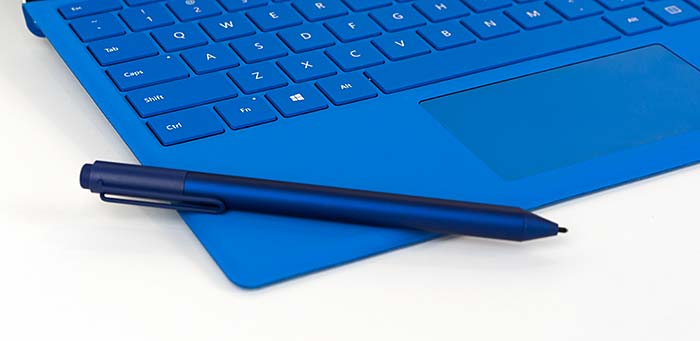
Is the Surface Pro 4 pen experience leaps ahead of Pro 3 when using the new pen on both? No, it's a fairly subtle improvement, but it's smoother in terms of pressure registration and latency is reduced. That latency (a delay before a stroke is drawn) will in part depend on the program you're using and the CPU model. We noticed that the Core m3 model had more latency than the Core i5, but it's not horrid. Both Core m3 and Core i5 work wonderfully for note taking in OneNote, which is still an eraser-click away. Press and hold the new pen's eraser to start Cortana and double-click it to take a screen shot.
The 12.3" IPS PixelSense display has 2736 x 1824 resolution, which is 60% more than Surface Pro 3. That's 267 PPI vs Pro 3's 216 PPI. It's extremely bright at 387 nits and it represents 99% of the sRGB color gamut and 75% of Adobe RGB (as measured with our Spyder4Pro colorimeter). That's similar to other high end Ultrabooks and tablets priced around $1,000 and up, but many of those ship with poor color calibration. Surface Pro 4 is calibrated from the factory and as shipped is one of the most accurate in terms of color rendition. Contrast is high at 1080:1, though not quite as high as Surface Book's. Unless you work with print production images or TV/cinema, the gamut is perfect. For those who do need full Adobe RGB, there's the Vaio Z Canvas, which is one of the few Windows tablets offering such a wide color gamut.
Viewing angles are wide, and glare is an issue despite the high brightness and bonded glass. In subdued office lighting glare isn't noticeable and I didn't spy myself reflected in the glass. The tablet's kickstand allows for nearly flat use (perfect for drawing and notes) and will firmly stand at any angle in the supported 22-150 degree range.
|
|

